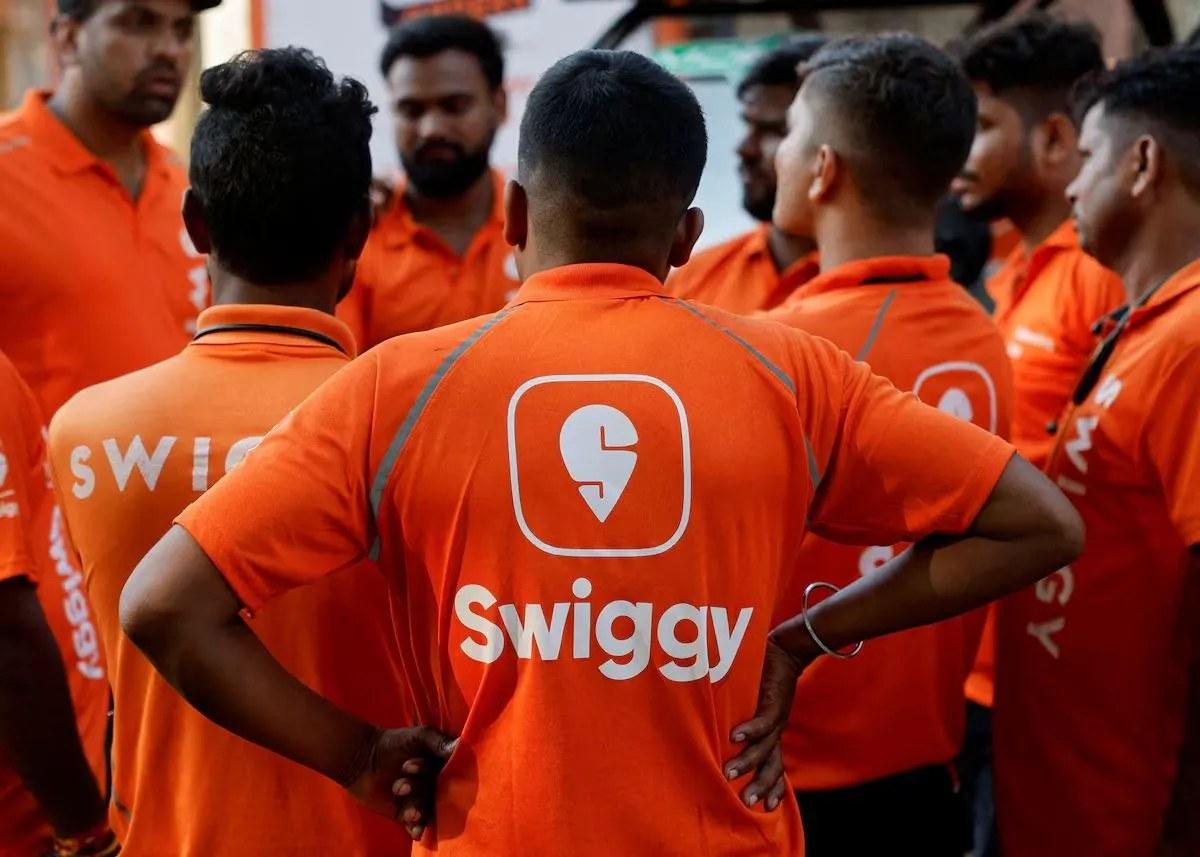Food delivery aggregator Swiggy saw its loss widen for the fourth quarter (January-March) of financial year 2024-25 (Q4FY25).

Photograph: Framcis Mascarenhas
The firm reported a consolidated loss of Rs 1,081.1 crore for the quarter, compared to a loss of Rs 554.7 crore in the corresponding quarter of FY24.
The platform’s consolidated revenue from operations jumped by 44.8 per cent to Rs 4,410 crore from Rs 3,045.5 crore in Q4FY24.
For the full year, the company reported a loss of Rs 3,116.7 crore, compared to the loss of Rs 2,350 crore in FY24.
Revenue for the full year touched Rs 15,227 crore, up 35 per cent year-on-year (Y-o-Y).
The company’s losses widened as it invested in the quick commerce (qcom) business.
Food delivery business reported revenue of Rs 1,629.3 crore for Q4FY25, up 18.4 per cent Y-o-Y.
Sequentially, revenue was flat with a marginal growth of 0.45 per cent.
Quick commerce revenue almost doubled to Rs 689 crore for Q4FY25 from Rs 320.7 crore in Q4FY24.
Swiggy MD and Group CEO Sriharsha Majety said that FY25 was a year of many firsts for the firm.
We launched multiple new apps, across Instamart, Snacc and, recently, Pyng, all of which are aimed at opening up new user-segments and markets, said Majety.
Our food delivery engine delivered the best-ever results across innovation and execution, driving category-leading growth and rising profitability in lockstep, he added.
Majety said the qcom industry is in a phase of rapid expansion and heightened competitive intensity, for which they have ramped up investments aimed at market expansion (Megapods), reach (over 1,000+ stores across 124 cities), and differentiation (Maxxsaver).
Our out of home consumption business turned profitable in Q4FY25, within just two years of its integration.
Overall, we remain focused on growth, on the back of delivering unparalleled convenience to consumers, said Majety.
Adjusted Ebitda (earnings before interest, taxes, depreciation and amortisation) grew 15.4 per cent quarter-over-quarter (Q-o-Q) and over five times Y-o-Y to Rs 212 crore, and strong efficiency and execution drove a margin expansion to 2.9 per cent of GOV, up from 0.5 per cent a year ago, said the firm.
On the other hand, the company’s qcom arm Swiggy Instamart accelerated its GOV growth to 101 per cent Y-o-Y (19.5 per cent Q-o-Q), clocking Rs 4,670 crore in Q4.
Average order value increased by 13.3 per cent Y-o-Y to Rs 527 crore.
Instamart added 316 new darkstores (+45 per cent Q-o-Q), its highest-ever during a quarter, driving up active darkstore area to 4 million square feet (msft) (+62 per cent Q-o-Q) in line with guidance, said Swiggy.
Investments in customer acquisition amid high competitive intensity saw MTUs (monthly transacting users) surge 40 per cent Q-o-Q to 9.8 million.
Led by these growth investments (which imply a lifetime-high proportion of new stores and users in the operating mix), contribution margin declined from -4.6 per cent in Q3FY25 to -5.6 per cent in Q4FY25, and adjusted Ebitda loss increased to Rs 840 crore, said the company.
Overall, Swiggy said the platform’s business-to-consumer (B2C) GOV rose about 40 per cent Y-o-Y to clock Rs 12,888 crore.
It said consolidated adjusted Ebitda loss Y-o-Y increased to Rs 732 crore due to significant growth investments in qcom.
The platform’s average MTU increased 35 per cent Y-o-Y to reach 19.8 million, with 35 per cent of all users utilising more than one service on the platform.
The company said that Q4 is a seasonally weak quarter coming after the festive season, though it does benefit late in the quarter due to a popular sporting event.
The qcom industry is going through a phase of heightened consumer awareness and store rollouts.
Hence, we brought forward our expansion plans and added more stores than originally envisaged during the second half (H2) of FY25.
With 498 new stores added over FY25, nearly half of our darkstores are less than a year old, with the average age of these stores being under four months, according to Swiggy’s shareholders’ letter for Q4FY25.
This has resulted in a higher underutilised network cost, which otherwise would have been spread over a longer period of time.
Alongside these, customer incentives (including delivery fee discounts) have been at an elevated level, led by competitive intensity and launches in new geographies.
The company said it had Rs 6,695 crore cash and cash equivalents as of March 31, 2025.
The shareholders letter said the firm’s 10-minute food delivery service Bolt provides a growing base of restaurant partners a full-stack and scaled-up route to participate effectively in the quick-food-delivery space.
Over 45,000 restaurant brands across more than 500 cities are on Bolt today, offering 47 lakh dishes spanning 26 diverse cuisines.
We work with restaurant partners on their internal processes to enable the preparation of food in sub-five minutes, while making available to them a delivery fleet almost on tap, said the company.
Disclaimer: This article is meant for information purposes only. This article and information do not constitute a distribution, an endorsement, an investment advice, an offer to buy or sell or the solicitation of an offer to buy or sell any securities/schemes or any other financial products/investment products mentioned in this article to influence the opinion or behaviour of the investors/recipients.
Any use of the information/any investment and investment related decisions of the investors/recipients are at their sole discretion and risk. Any advice herein is made on a general basis and does not take into account the specific investment objectives of the specific person or group of persons. Opinions expressed herein are subject to change without notice.




